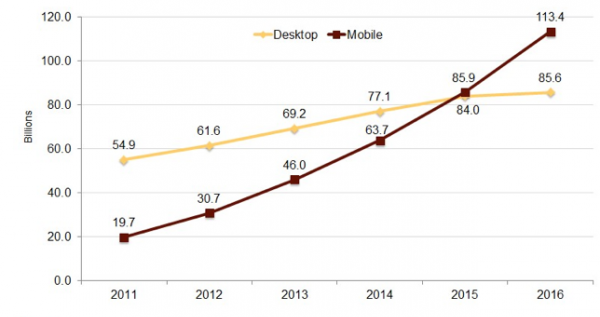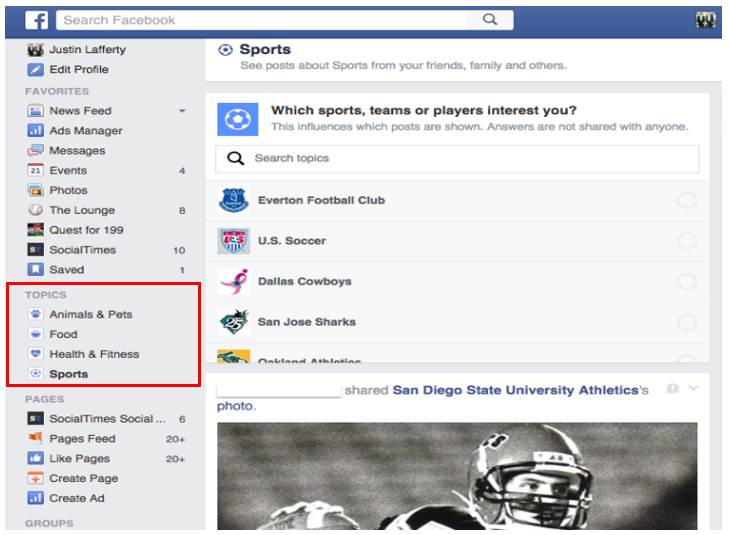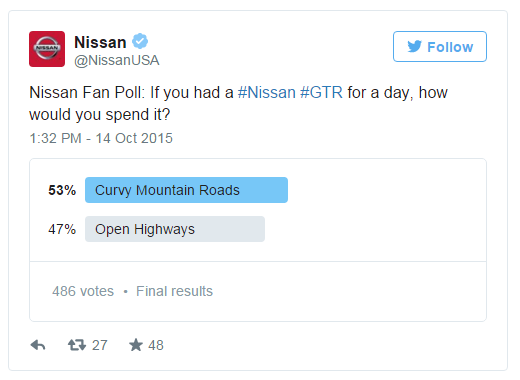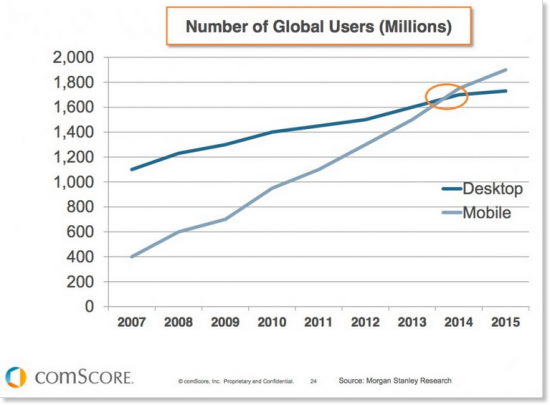by Charles River Interactive | December 4, 2015 | Industry Trends, Organic Search
CRI has researched the future of voice search and how it relates to the ongoing SEO strategy for our clients. Mobile search has overtaken desktop searches and companies need to tailor their SEO practices towards this growing trend, which now includes voice search.
US Local Search Market: Mobile vs. Desktop

What is Voice Search?
The popularity of voice search is growing as more searches are conducted on mobile devices. Voice searches are conducted when a user talks to their device to obtain information that would have normally been searched by typing in a query. The Google Search App for iOS and Android gives you the ability to ask a question out loud and the search app will speak your answer right back to you. Users are not given a list of SERPs and instead are receiving one piece of information at a time. This information is populated from optimizations made to the content of the pages and Knowledge Graph information. Voice search is available on desktops as well; the little microphone in the search bar gives users the ability to speak their search query.

The growing popularity of smart watches has increased the use of voice search in 2015 and that trend will continue in 2016. Smart watches provide one answer to search queries and optimizing your content towards those search queries is important.
How Does Voice Search Benefit Clients?
Studies have shown that mobile queries have strong local intent (between 40%-80%); using these stats, we can assume mobile and wearable devices are going to provide a plethora of local search results. More so, this is the kind of intent we want to make sure we’re properly optimized for, as on average, a mobile query results in two follow up actions by the user. Those follow up actions could consist of asking for more information or asking for directions.
Having optimized content that focuses on conversational keywords will help clients show up as the number one option when their keyword phrases are voice searched. By keeping ahead of the curve, and by anticipating the advances in voice recognition and natural language search criteria, businesses have a better shot at improving, and maintaining, their online visibility in the future.
Building out Google’s Knowledge Graph
The use of Google’s Knowledge Graph is an integral part of the process that gives users smarter answers.

Building out the content on the website and utilizing robust Google My Business pages is an important part of populating the Knowledge Graph with usable information. A new method for doing this is JSON-LD, which uses Google Tag Manager and JavaScript to tell Google what the most important accurate information is. By using this code, we can build relationships between the site and crucial content so that Google can place more emphasis on that information being pulled into the Knowledge Graph. The Knowledge Graph then provides accurate information to all the voice search queries.
CRI works with clients to implement conversational phrases into the FAQ page and other important pages that mimic what a user might ask on their mobile device. Using these long tail keywords will capture more of the traffic using mobile and wearable devices with voice search activated. The use of these phrases can be fine-tuned so they work with existing content.
In Conclusion
Writing content the way your audience speaks is one of the best ways to engage with people that search for your page and it keeps them coming back. In the past, targeting specific keywords was enough to boost your rankings with search engines. Users are now searching in more broad terms that include sentences. “Where is Acme Motors located” and “What time does Acme Motors close” are a couple of examples of queries that might be searched by voice. People search for things the way they speak and ask questions, so it is important to build out pages with all the relevant information needed to achieve a positive result when one of these questions is asked.
Wearable device searches are going to gain more popularity since users will be doing more voice searches. Websites that answer questions and use common phrasing are going to outrank those that are just stuffed with keywords in their content. Optimizing a website for voice searches takes this semantic thinking to a new level. A voice search is done in a more conversational, natural way, so a website must be optimized accordingly. By shifting the SEO focus to include this portion of the search traffic, we can position our clients for success in local and voice search.
by Charles River Interactive | November 10, 2015 | Industry Trends, Organic Search, Uncategorized
Changing the domain of a well-established website comes with some risks that may have an adverse effect on site authority, rankings, and traffic. Weighing these potential risks before the domain change is made is vital to the continued health of the site.
Authority can be divided into two pieces: domain authority and page authority. Domain authority measures the predictive ranking strength of the entire domain or subdomain; page authority measures the strength of an individual page. Both of these measurements are rated on a 100-point logarithmic scale that becomes increasingly more difficult to achieve as the scale nears the maximum possible points.
Rankings are based on a number of different factors that include keywords, content, page layout, page authority, and social signals. Each of these factors is weighed and a ranking is assigned to each page of the website based on the search engine used. The rankings are what search engines use to order websites in a SERP (search engine results page).
Traffic is simply the number of visitors that land on a website through various paths. These paths include organic, paid, direct, social media, and others. The volume of traffic greatly depends on the ranking results that are assigned. Therefore, if a page shows up low in the search results then it is less likely to be clicked on and visited.
Analysis of Current Domain
This example demonstrates one of the highest authorities in Google’s index with a domain authority of 96 (remember, 100 being the highest) and a home page authority of 83 (100 being the highest again). These results are very significant and demonstrate a strong ranking, both which would suffer from a domain change.

One other factor to consider is social signals. In the example above, this company has substantial social metrics which result in increased social signals that Google weighs when ranking a site within search engine results. Social signals do not transfer when a domain is changed so this company would be forfeiting their current metrics and need to rebuild.
Domain Change Next Steps
There are a number of steps that should be implemented to properly execute a domain change if it is decided that the change is necessary or worthwhile.
Before the Domain Update
1. Do an Audit
It is important to audit all statistics before transferring domain names. This will help get a better understanding of everything going on associated with the domain and will give a benchmark in which to see progress from after the switch. The biggest component to audit is the inbound links coming to the site. This is important because it is the biggest SEO ranking factor and when changing domain names it is important to minimize losing good links.
Next, review all the links to look for the best quality ones and highlight them. The best links should be revisited and checked that they are still linked and 301 redirecting properly after transferring domains.
Additionally, conduct an audit on the top keywords that are being searched for that drive visits to the website. This will be used after the launch as talked about below.
2. 1 to 1 301 Redirect Everything
Setting up a 1 to 1 301 redirect will not only send the user to the correct page but will also tell search engines that the page has permanently been moved and will transfer the link credit to the new page. It cannot be stressed enough how important it is to take time and make sure everything is getting 301 redirected properly. This is very important for both traffic and search.
3. Keep the Same URL Structure
It is highly recommended to keep the exact same URL structure while switching domains. There are enough changes that both the site and Google have to account for in a domain name switch, to change all the URLs as well would result in even more loss in rankings and traffic. If you want to make changes to the URL structure, it’s best to wait a few months after the domain transfer, once things have settled, and then make the changes.
4. Tell Google You Moved
Submit the new domain to Google and update the domain in their system so all listings are up to date.
After Domain Update
1. Thorough Check
The day of migration, double and triple check everything is linked properly and 301 redirected appropriately. Use the keyword audit performed to review all the keywords that were driving traffic to the site and search for them on Google. Then confirm that they are 301 redirecting properly. Additionally, review the top inbound links and check to see if they are properly redirecting.
2. Monitoring 404 Errors
A 404 will happen when a page doesn’t get redirected properly. Be sure to monitor and update any 404’s that might occur. Check every day for the first week and update any pages that might be returning a 404 error. Continue to review once a week for the first month after the change to keep track of any possible 404 errors that might happen after the launch. Sometimes it can take a few weeks for some to surface.
3. Plan a Big Marketing Push Post Launch
It is pretty common that after the transfer of a domain, search rankings will decrease. Knowing this in advance, it’s important to plan a big marketing push for right after launch to help bump the rankings and return to or, better yet, exceed previous success.
4. Content Push
Implement new site content. Blogs are a particularly good way to expand content and getting multiple blogs posted will drive traffic to the site, and are more likely to get linked to and shared.
Conclusion
Some domain changes are a necessity and have to be completed for the betterment of the company. Even if the domain change is completed correctly, it can result in a drop in the authority numbers which will decrease the rankings, and therefore, an overall drop in traffic as domain authority is not transferable.
Websites that are well established and have years of successful data should stay on the existing domain whenever possible. The history of data can be lost with a domain change and the site would need to start building authority all over again. It would be difficult to recapture the examples’ numbers with a domain change and, in fact, they may never return to such high levels.
If the domain were to change it would undoubtedly lose authority in the process. Instead, consider leaving the domain in the current location and build the changes directly into the site content. If a change must be made then the list of steps and processes above should be executed to ensure the lowest amount of lost authority as possible.
by Charles River Interactive | November 3, 2015 | Industry Trends
Written by Bethany Critchley and Kathryn Falco
Over the past couple of weeks, Facebook and Twitter have been hard at work rolling out new features for both their individual users and their advertisers. Below is an overview of some great new tools the platforms have unveiled to individual users and advertisers alike.
Facebook begins testing new Topic-Based Feeds feature
Until recently, users’ feeds have been primarily composed of statuses, pictures, re-posts, promoted posts, etc. all of which were, for the most part, out of their control. Though Facebook did its best to show and suggest posts similar to ones that users “liked” or promoted themselves, it was easy to get lost in all of the information (and irrelevant relationship statuses) that were constantly being displayed. That is, until now.
Last week, Facebook started testing out a new feature – Topic-Based Feeds. Users within the test were given the ability to choose specific topics to be displayed in their newsfeeds by clicking on their particular interests within the Topics toolbar (found on the left side of the menu). The Topics, Animals & Pets, Food, Health & Fitness, and Sports, were then further refined based on users’ preferences after answering questions on the topics they chose.

Because this feature is still a test, the platform also gave users the ability to “flag” posts that they deemed irrelevant to the chosen topic (a smart move on Facebooks part considering users often feel they do not have much say in what appears in their feeds).
The feature has not been completely rolled out and is only open to random users for now, but it is definitely a step in a new direction for the social giant. Facebook is still the dominant social network, but other platforms are starting to creep up on them.
People predominantly use Facebook to stay tuned-in to what their friends and families are doing on a daily basis, but they are often overwhelmed by the unnecessary information that other people are posting. From a strategic standpoint, it seems this is a positive move on Facebooks part. Users will feel like they have more of a hand in what they see in their feeds instead of feeling lost in a sea of information and emotion. But for those users who prefer to stay up to date on who is newly engaged, who recently broke up, and who is having babies, they can choose to stick with the normal news feed.
For more information on the Facebook Topic-Based Feed check out this article on MarketingLand.
Facebook introduces new “Slideshow” ad unit for emerging markets
What is it?
Slideshow is a new video substitute. Advertisers are able to create video ads from still images. Upload 3 to 7 still images and choose the length of the slideshow which ranges from 5-15 seconds. You are able to use video like motion with no sound to provide a new way to tell brand stories.
Why was it created?
It was designed to play in markets where mobile connections are slow or unreliable. Due to the smaller file size, it allows eye catching ads to people with poor connection.
How does it work?
Advertisers create two campaigns, one being a traditional video and the other a slideshow. Facebook detects the user’s connection speed and then shows the appropriate ad. This feature is at no additional cost.
Useful to You?
Although a very cool feature it may not be completely relevant to our Facebook ad campaigns in North America, since we generally have good connection to service. Facebook released that more than half of its revenue comes from non-North American markets, where the dominant form of internet access is mobile but on a slow connection. So this could be something interesting to test for clients that we are running Facebook campaigns internationally.
On a bigger scale, Coca-Cola ran these types of campaigns in markets such as Kenya and Nigeria and had great results. You can find out more information on this case study on FaceBook and VentureBeat.
Twitter rolls out Native Polling feature
Nowadays, everyone has an opinion on everything and Twitter just made it that much easier to voice yours. Regular users of the network are all too aware of the “Retweet for Yes, Favorite for No” Tweets that float around within their feeds. From big Brands to individuals, users understand that these Tweets are a fun way to get followers to engage and interact with a Tweet.
As of last week, Twitter started rolling out a new feature that allows users to quickly share their opinions on social media – Native Polling. Let’s be honest, it’s pretty cool and don’t even deny that you can’t wait to start using it. Though the feature has been in test mode over the past month, it will now be available to all users.
In the past, these polls were only available to advertisers using custom Twitter Cards who were asking questions and tracking responses. The new poll feature is a simple “query” with two possible answers with results being displayed in real-time. Each poll is active for 24-hours and users can also see how much time is left to “vote.” Once the 24-hour limit has been reached, the results are displayed as a percentage. Not only that, but Twitter sends a notification to all poll participants, prompting them to “check out” the final results.

The new feature will be rolling out over the next few days on iOS, Android, and Twitter.com.
In our opinion, this is one of the most useful Twitter features we’ve seen in a while. Not only is it fun for the average person, but this is huge for Brands seeking to engage their followers and attract more. Though there is no information yet on whether this will be available within the ads platform, it’s probably safe to assume that that won’t be far behind.
Social Media is an ever-growing, ever-changing way to be noticed by the public. That is even more true when it comes to advertisers. There is no better way to reach a target audience than to market them with products and services in places and outlets that are relevant to their daily lives. Users are on social media because they are looking for better ways to fulfill their lives and they look to other users to influence their choices (whether consciences of it or not). In a society that has grown up and into the social media world, it is essential for advertisers to take advantage of an audience that is, for lack of a better word, begging to be marketed to.
You can find out more information on this new Twitter feature at MarketingLand.
by admin | March 27, 2015 | Industry Trends, Paid Search, Uncategorized
Why Do You Need a Mobile Website?
With technology constantly growing and advancing, the average website now receives approximately 60% of its traffic from a mobile device.[1] Google reports that 94% of people with smartphones search for local information on their phones and 77% of mobile searches occur at home or work, places where desktop computers are most likely to be present. In 2014, the number of mobile users surpassed the number of those using a desktop. These statistics confirm the growing popularity and need for a company’s mobile presence online, including the need for a well-constructed mobile website.

Updates to Mobile Search
In April 2015, Google will introduce mobile-friendliness as part of their search algorithm. This update will put emphasis on sites designed for mobile search and give priority to these pages in search results.
Google has also made a number of display updates for mobile search results, including separating results with a colored line
and app indexing, where users will be served a link to a previously downloaded app if appropriate. Google now labels mobile friendly websites directly within search results. Having this label may help increase click through rates, as users know a mobile friendly website is more likely to load quicker and will be easier to navigate on their device. You may also see the word “slow” next to websites with long page load times.
Google also has available a Mobile Usability report within Webmaster Tools and a PageSpeed Insights tool for mobile sites. This is a great start for understanding where your website currently stands in terms of mobile usability.
What is a Mobile Website?
The most common type of mobile website uses a “responsive design.” A responsive design website is a single website coded to “respond” to the device of a user. With this design, the website can adapt by changing the width of columns, text size, button spacing, etc. to offer optimal mobile viewing for the user.

Another type of mobile website is the “M.” site (m.site.com), which creates a separate mobile website. These sites are becoming less popular as they often provide a poor user experience and require much more coding to maintain. Mobile-only pages also need to build up their own reputation (content, links, etc.) because they do not receive shared indexing signals from an existing desktop version of the page.
[1] http://smallbiztrends.com/2014/07/online-traffic-report-mobile.html
by admin | December 20, 2013 | Industry Trends, Uncategorized
Has your Twitter feed seemed a little different lately? If you’re seeing strange things, don’t worry, you’re not crazy! After several months of testing, Twitter has decided to let advertisers target its users via the use of cookies.
Twitter users have been in control of who they follow (and even who follows them, depending on privacy settings) since launching in 2006. Since 2010, users have been shown Promoted Tweets, Promoted Trends, and Promoted Accounts throughout their timelines, which are all forms of paid advertising on the social media platform. These promoted forms of media (whether it be Tweet, Trend, or Account) are only to be shown to the user if it is deemed highly interesting/relevant to the individual.
Twitter Announces Tailored Audiences
Users will now be served ads via Twitter’s “Tailored Audiences”. These audiences will give social media advertisers the ability to better target different groups with customized messaging. Audiences may be made up of preexisting customers, as well as potential new ones, and the advertiser is now able to serve the most relevant message to each audience.
(more…)








